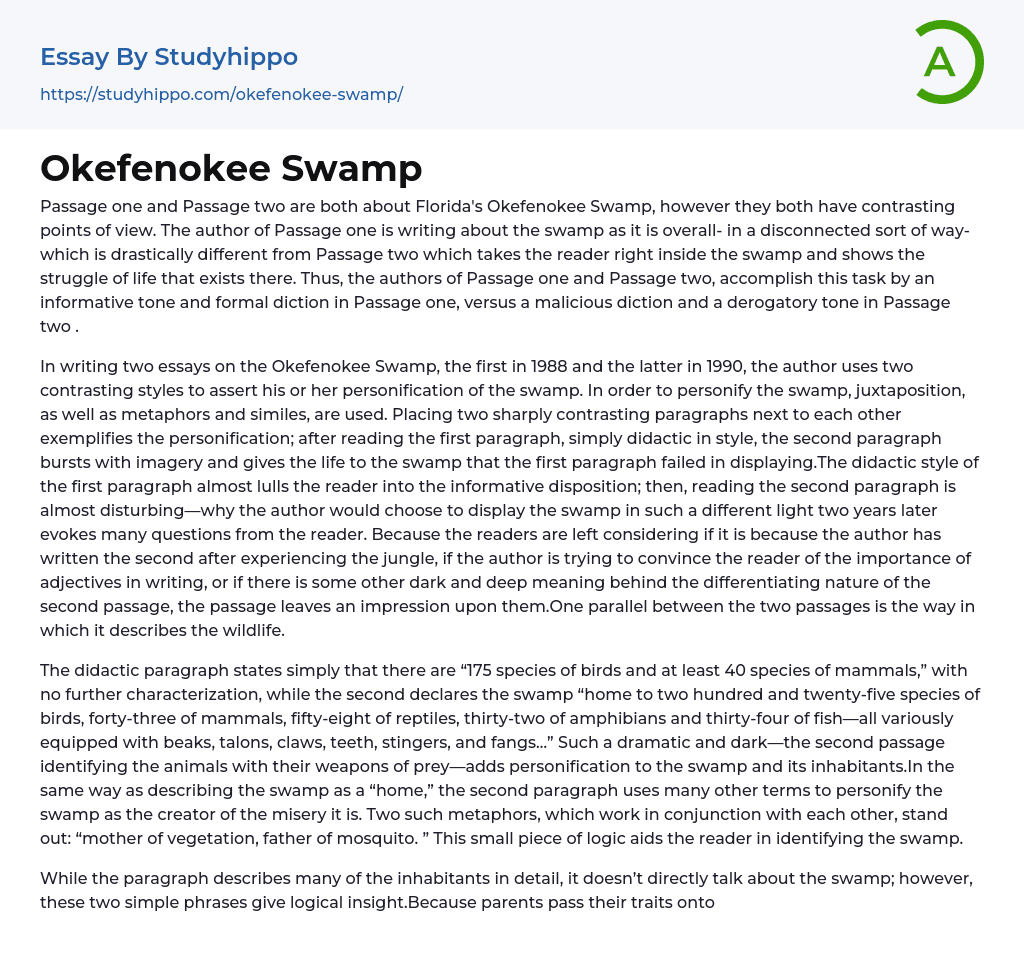
Passage one and Passage two are both about Florida's Okefenokee Swamp, however they both have contrasting points of view. The author of Passage one is writing about the swamp as it is overall- in a disconnected sort of way- which is drastically different from Passage two which takes the reader right inside the swamp and shows the struggle of life that exists there. Thus, the authors of Passage one and Passage two, accomplish this task by an informative tone and formal diction in Passage one, versus a malicious diction and a derogatory tone in Passage two .
In writing two essays on the Okefenokee Swamp, the first in 1988 and the latter in 1990, the author uses two contrasting styles to assert his or her personification of the swamp. In order to personify the swamp, juxtaposition, as well as metaphors and similes, are
...used. Placing two sharply contrasting paragraphs next to each other exemplifies the personification; after reading the first paragraph, simply didactic in style, the second paragraph bursts with imagery and gives the life to the swamp that the first paragraph failed in displaying.The didactic style of the first paragraph almost lulls the reader into the informative disposition; then, reading the second paragraph is almost disturbing—why the author would choose to display the swamp in such a different light two years later evokes many questions from the reader. Because the readers are left considering if it is because the author has written the second after experiencing the jungle, if the author is trying to convince the reader of the importance of adjectives in writing, or if there is some other dark and deep meaning behind
the differentiating nature of the second passage, the passage leaves an impression upon them.One parallel between the two passages is the way in which it describes the wildlife.
The didactic paragraph states simply that there are “175 species of birds and at least 40 species of mammals,” with no further characterization, while the second declares the swamp “home to two hundred and twenty-five species of birds, forty-three of mammals, fifty-eight of reptiles, thirty-two of amphibians and thirty-four of fish—all variously equipped with beaks, talons, claws, teeth, stingers, and fangs…” Such a dramatic and dark—the second passage identifying the animals with their weapons of prey—adds personification to the swamp and its inhabitants.In the same way as describing the swamp as a “home,” the second paragraph uses many other terms to personify the swamp as the creator of the misery it is. Two such metaphors, which work in conjunction with each other, stand out: “mother of vegetation, father of mosquito. ” This small piece of logic aids the reader in identifying the swamp.
While the paragraph describes many of the inhabitants in detail, it doesn’t directly talk about the swamp; however, these two simple phrases give logical insight.Because parents pass their traits onto their children, the idea that the swamp is the “mother” or “father” of all the despicable creatures described allows the reader to associate the traits of those same creatures to its parent, the swamp; indeed, another closely following metaphor, “soul of silt,” gives hint to the underlying and deeply personal nature of the swamp.The four letters of the passage, and indeed another simile, accurately sum up the life of the swamp: “like some hellish
zoo. Personifying the swamp is made easy when the two passages are placed next to each other—the didactic first exists to serve the second in allowing the reader to appreciate the dark and heavy similes and metaphors. It is probable that shock factor was important in the author’s ability to accurately identify the swamp, and both of these literary devices serve that purpose.
- Rabbit essays
- Distribution essays
- Large Animals essays
- Mouse essays
- Poultry essays
- Animal Abuse essays
- Cats Vs Dogs essays
- Cattle essays
- Territory essays
- Boo Radley essays
- Genesis essays
- Richard iii essays
- Alice in Wonderland essays
- On the road essays
- Ozymandias essays
- The Nightingale essays
- Holden Caulfield essays
- Animal Farm essays
- 1984 essays
- A Hanging essays
- Shooting An Elephant essays
- A Tale Of Two Cities essays
- Adventures Of Huckleberry Finn essays
- Arthur Conan Doyle essays
- Brave New World essays
- Characters In Hamlet essays
- Characters In Romeo And Juliet essays
- Desdemona essays
- Diary Of A Wimpy Kid essays
- First-Person Narrative essays
- Frankenstein essays
- Heart Of Darkness essays
- Jane Eyre essays
- Jay Gatsby essays
- King Duncan essays
- Librarian essays
- Little Red Riding Hood essays
- Lord Of The Flies essays
- Silas Marner essays
- The Cask Of Amontillado essays
- The Catcher In The Rye essays
- The Crucible essays
- The Handmaid's Tale essays
- The Reader essays
- Virgil essays
- Wuthering Heights essays
- Candide essays
- Castle essays
- J. D. Salinger essays
- Ulysses essays



